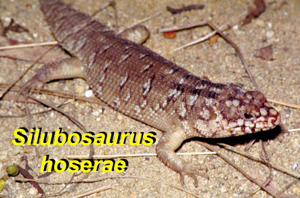 Spectacular new large spiky lizard discovered in the Mount Isa area.
Spectacular new large spiky lizard discovered in the Mount Isa area. Spectacular new large spiky lizard discovered in the Mount Isa area.
Spectacular new large spiky lizard discovered in the Mount Isa area.28 April 2018 New to science: An overlooked large species of skink lizard had been formally discovered and named in the Australasian Journal of Herpetology in recent weeks. Media inquiries: Phone: (Australia) 0412-777-211 To download hi-res images of Silubosaurus (or Egernia) hoserae Hoser, 2018 click on the linked images below. Further reading: Full Journal (Issue 36, AJH including covers). Return to index for all AJH Published Issues of Australasian Journal of Herpetology The full book - download for free as pdf - Australian Reptiles and Frogs
It lives in rock outcrops in colonies, is large, spectacular in appearance and common as mud in the Mount Isa region.
Known as Silubosaurus (or Egernia) hoserae Hoser, 2018, this lizard had been long confused with a different species Egernia hosmeri Kinghorn, 1955.
The confusion arose because the original Egernia hosmeri Kinghorn, 1955 scientific description was based on a poor quality preserved and faded specimen lodged in a museum.
The colour fading occurs when the specimen is preserved in spirit. That species happens to be restricted to the Einasleigh uplands west of Cairns.
Over following decades the more widespread and common species now known as S. hoserae was misidentified in the literature as E. hosmeri, which had been perpetuated until now.
S. hoserae is naturally light yellowish in colour, making it superficially similar to the also spiky E. hosmeri when faded in a jar.
When doing a taxonomic review of all of Australia’s spiky skinks (Egernia sensu lato), Australia’s Snakeman Raymond Hoser found that there were in fact two species of so-called “Hosmer’s skinks”, expecting the new and unnamed species to be the relatively uncommon form from west of Cairns. However an inspection of the relevant type specimen confirmed the reverse was the case.
The genus name Silubosaurus was coined by British zoologist John Edward Gray nearly 200 years ago. The species name hoserae is in honour of Hoser’s wife, Shireen who has made a valuable contribution to wildlife conservation and science over more than 20 years.
The new species is already widely known among herpetologists as the Hoser’s Skink.
Snakeman Raymond Hoser is the world’s foremost reptile expert and been working on Mount Isa’s reptiles for more than 4 decades. He has discovered and named hundreds of species of reptile including over 100 in Australia and numerous others from the Mount Isa region. Included species Hoser has discovered from the Mount Isa region are the Pygmy King Brown Snake (Pseudechis pailsei) that he discovered and named in 1998, a giant 1.5 metre long Goanna Lizard (Pantherosaurus maxhoseri) from black soil plains south of Mount Isa in 2015, as well as numerous species of dragon lizard, gecko and legless lizard in the Mount Isa region.
Last month Hoser also named a species of Snapping Turtle from the Daintree River in far north Queensland, this being the fifth species of turtle he has discovered and named including one other in Queensland, one in Florida and 3 elsewhere.
All relevant species named by Hoser have had their validity confirmed by molecular methods including mitochondrial DNA divergence.
Hoser regularly travels to remote areas like Mount Isa to do snake catcher courses for reptile handlers and others. He is also internationally known as the man who first invented the children’s reptile party, an educational concept that has now been copied worldwide and is of major benefit to wildlife conservation.
With over 300 new species of reptile and frog being discovered and named every year, Hoser says that "our biodiversity is clearly not fully recognized and in the face of human population growth we need to properly identify it and manage it as soon as we can".
"Naming a species is the first and most important step in biodiversity conservation".
Hoser has authored nine best selling books, including the so-called "Bible's", Australian Reptiles and Frogs (in 1989) Endangered Animals of Australia (in 1991), the latter widely regarded as the most significant contribution to wildlife conservation in Australia's history.
He has also published hundreds of peer reviewed scientific papers in journals globally.
Hoser also said "Mount Isa was first identified by myself more than 20 years ago as a biodiversity hotspot and since then this has been confirmed by further discoveries of several significant biogeographic barriers to reptile species movement on every side of the Selwyn range. I have no doubt that further species await discovery in the region.
Note: These lizards have traditionally been placed in the genus Egernia, but this is in fact a very different group of spiny lizards from cold parts of south-east Australia. Silubosaurus was a name formally assigned to this clade of lizards by John Edward Gray of the British Museum, more than 150 years ago.
Photo credit: Snakeman Raymond Hoser. Photos may be used by others in line with the the Snakebusters legal statement for images and the like at:
http://www.smuggled.com/kotabi4.htm